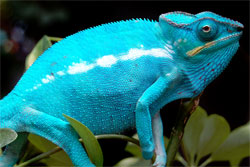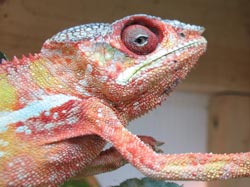Follow along with the video below to see how to install our site as a web app on your home screen.
Note: This feature may not be available in some browsers.
You should upgrade or use an alternative browser.
Purchasing A Chameleon


Finding a new pet is an exciting process and knowing what to look for will help you and your new chameleon start off on the right foot.
It is highly recommended to purchase only captive bred chameleons. Many thousands of animals are still imported from the wild each year and they are frequently in poor condition and poor health. These wild caught chameleons are difficult to acclimate to captivity and continued importation damages the dwindling wild populations. Though they are often cheaper, it is worth spending a little extra to support responsible captive breeding programs and get a more healthy chameleon. Make sure to ask if the chameleon you are considering is wild caught or captive bred before purchase. It is also very important to know exactly what species you are getting so you can provide appropriate care. Many chameleons are mislabelled at sale so verify your new purchase with a reputable source if you are at all unsure of the species.
Chameleons can be purchased from local pet stores, reptile expos and breeders. The sponsors at Chameleon Forums have a history of responsible breeding and are invested in their animals' care. Regardless of the source, it is important to look for basic signs of health before purchasing your new chameleon. A chameleon will hide illness for as long as possible so if they already are showing signs of poor health that means they may be very ill and you should reconsider the purchase. It is especially important for a new owner to start with a healthy chameleon as a sick one is more challenging to care for, may need expensive veterinary treatment, and can be a sad and frustrating experience if the chameleon passes away.
Warning: We strongly recommend only purchasing chameleons that are at least 2-3 months of age. Baby chameleons can be extremely fragile and buying a more established animal gives new owners a much better chance at success. Most ethical hobbyists and breeders will not sell chameleons that are too young.

Review these features and behaviors to help ensure the chameleon you are interested in is healthy.
- A healthy chameleon should be active in its environment and standing up rather than laying on its perch.
- The chameleon should be able to move about the cage with good balance without falling or stumbling.
- The eyes should be full, open at all times and actively looking all around.
- The arm and leg bones should all be straight, toes should all be intact and the chameleon should have a strong grip.
- Skin should have vibrant coloration all over the body and all the spines on the back should be present.
- Patches of shedding skin are normal if present.
- The tail should be able to grasp branches and curl up smoothly.

The symptoms below are possible signs of illness. Unhealthy chameleons should not be purchased except by very experienced owners.
- Sleeping during the day at all.
- Sunken or swollen eye turrets.
- Laying on the bottom of the cage.
- Legs that are bent, curved, appear to have multiple joints or have swellings at the joints.
- Wrinkly, crusty or dry skin, bumps, cuts or bruises, or patches of abnormal colored skin.
- Blood at the mouth, swollen jaw, or jaw that doesn't align properly.
- A tail that cannot curl or is black at the end.
- Falling off branches, having a weak grip, stumbling or appearing very clumsy.

Ideally your cage should be completely set up and ready to go before you purchase a chameleon. In addition to knowing what to look for in a new chameleon, it is also important to understand the financial burden involved. Chameleons themselves may not be very expensive, but the setup and maintenance required to keep them healthy often is! For a good example see Cost of Keeping Chameleons.
Regardless of the source of your new chameleon, whether or not it was wild caught or captive bred, every new reptile should be strictly quarantined from all other animals for a minimum of 45 days. Quarantine is used to both assess the health of your new animal and prevent introducing an illness to your other pets. Chameleons will hide signs of illness for as long as possible and the stress of shipping, traveling or even just a new environment can trigger that hidden ailment. Failing to quarantine a new animal properly could expose your collection to a potentially devastating infectious disease.
Your new chameleon should be kept in a completely separate room from your other chameleons and reptiles for at least 45 days. Handle and feed all your regular animals before any quarantined animals to prevent contamination. Use completely separate equipment on quarantine animals and wash your hands well. Fastidious cage hygiene (cleaning cage and cage furnishings) should be done daily to prevent re-infection of germs and parasites. Many imported or new chameleons have intestinal parasites, so a fresh fecal sample should be dropped off at your veterinarian for testing and diagnosis.
Unfortunately the unique needs of chameleons are still often overlooked by pet stores and many chameleons in pet stores are in poor conditions with caging being inadequate or are already showing signs of illness. The first response of the compassionate customer is always "I should rescue it from these terrible conditions!" This may surprise you, but it is actually recommended to not purchase these animals in poor conditions. We all want to save an animal in need, but to the pet store that chameleon is just another product that needs to be sold for profit, and it's all about the numbers. If you purchase that chameleon to save it the pet store sees that as no more than a successful sale, and they will quickly replace it with a new chameleon to sell in the place you opened up. Nothing will encourage them to improve conditions since they can sell them to you without investing in proper care. However, if that chameleon does not sell then the store does not find that profitable and will stop stocking chameleons in those terrible conditions. It is much better to spend your money supporting responsible breeders or even other stores that put in the effort to make sure they have healthy animals in good conditions.
